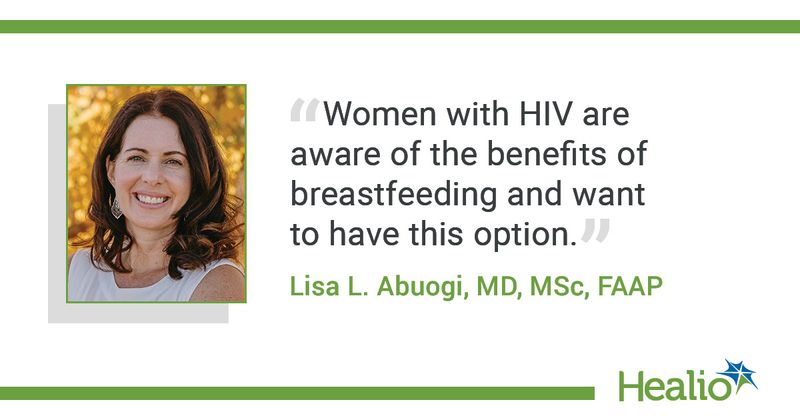Q&A: AAP reverses stance on breastfeeding with HIV
Key takeaways:
- The AAP now says parents with HIV who are virally suppressed on ART can breastfeed.
- Parents with HIV who are not on treatment or are not virally suppressed on ART should continue to refrain from breastfeeding.
The AAP reversed its long-held stance against breastfeeding with HIV, now saying that parents with HIV who wish to breastfeed should be supported in their decision, so long as they are on treatment and virally suppressed.
The AAP continues to recommend that parents not breastfeed if they have untreated HIV or are on ART but not virally suppressed.

According to a new clinical report written by members of the AAP’s Committee on Pediatric and Adolescent HIV who focus on breastfeeding, “avoidance of breastfeeding is the only infant feeding option with 0% risk of HIV transmission.”
“However, people with HIV may express a desire to breastfeed, and pediatricians should be prepared to offer a family-centered, nonjudgmental, harm reduction approach to support people with HIV on ART with sustained viral suppression below 50 copies per mL who desire to breastfeed,” Lisa L. Abuogi, MD, MSc, FAAP, and colleagues wrote.
The AAP’s new stance brings it in line with new recommendations adopted by the CDC last year. Until that update, the CDC had recommended against breastfeeding with HIV since 1985.
According to Abuogi and colleagues, nearly 5,000 people with HIV give birth every year in the United States, and without treatment, pregnant people with HIV can pass the virus to infants during pregnancy, delivery or breastfeeding. ART, however, can keep people with HIV healthy and significantly reduce the risk for transmission.
To learn more about the AAP’s decision, Healio spoke with Abuogi, an associate professor of pediatrics at the University of Colorado Denver.
Healio: Why was now the right time to update this position? The “Undetectable = Untransmittable” guidance for HIV and sex is at least 6 years old. Did it just take longer for the evidence to accumulate about the safety of breastmilk from a parent on ART?
Abuogi: Research demonstrating that breastfeeding can be safe in a person with undetectable viral load on ART took additional time. We have examples of women with undetectable viral loads whose infants still acquired HIV, and so we cannot say “undetectable equals untransmittable” for breastfeeding.
Consider that an infant will breastfeed eight to 12 times per day for 4 to 6 months and maybe longer. While the risks for HIV transmission during sex are a bit different than through breastmilk, it’s clear that people are not having sex eight to 12 times a day for 6 months straight! So, exposure is also less for sexual transmission than breastfeeding.
The AAP has a very rigorous and thorough process of peer review and oversight for updating positions. We initiated this process 2 years ago, first obtaining approval for the revision, then getting input from every section and committee and going through several rounds of revisions, with final review and approval by the AAP board and executive committee.
Healio:What is a recommendation and explanation that a clinician can give to a lactating parent with HIV who is on ART and may want to begin breastfeeding?
Abuogi: “We know that less than one out of 100 breastfed babies would be expected to get HIV through breastmilk when you are on ART and have an undetectable viral load. What information or questions can I answer for you to help you decide how you would like to feed your baby?”
Healio: Are there common misconceptions about breastfeeding and HIV?
Abuogi: Some people think that no one with HIV would want to breastfeed if there is any risk at all for the baby acquiring HIV. But women with HIV are aware of the benefits of breastfeeding and want to have this option. Many feel they can’t fulfill their role as a mother if they do not breastfeed, which leads to guilt and shame.
Many providers were trained that breastfeeding is contraindicated or not allowed for parents with HIV, but this is no longer the case. That’s why sharing this clinical report with pediatric providers is so important.
Healio: Is there a lot of stigma around HIV and breastfeeding? How can a provider address that with a patient?
Abuogi: Stigma is an important issue facing people with HIV and is a part of infant feeding decisions. Women have expressed that not breastfeeding can effectively disclose their HIV status in certain communities in which breastfeeding is expected.
Providers can normalize discussions about infant feeding. Infant feeding education and planning are a normal part of pregnancy for women in the U.S. Providers can incorporate infant feeding discussions in the same way for pregnant people with HIV.
Healio: How can clinicians offer, as the report says, “family-centered and nonjudgmental support for people who desire to breastfeed”?
Abuogi: Family-centered means asking the pregnant patient who else they would like to include in the conversation — such as a partner or spouse, other family member or friend — and including them in the infant feeding counseling.
Being nonjudgmental includes not using directive counseling that tells a patient which infant feeding approach is best for them but gives information and options where appropriate.
It’s important that the voices of people and women with HIV are included in these discussions. Women and others in the HIV community have advocated for these changes and their voices are critical.
Reference:
Abuogi LL, et al. Pediatrics. 2024;doi:10.1542/peds.2024-066843.
